1. INTRODUCTION
Boron compound is rarely applied alone in recent studies; rather it has been engineered by altering the method and adding other materials. The additional material can be used to cover wood surface (Priadi et al., 2021; Temiz et al., 2008) or as adhesive (Thévenon et al., 1998; Verly Lopes et al., 2020) to keep boron consistency in the wood.
Wood modification is potential to improve low durability wood, particularly from fast growing species, such as Samama (Anthocephalus macrophyllus (Roxb.) Havil) (Cahyono et al., 2015). Samama wood belongs to strong class II-III and durability class IV (Halawane, 2015; Tuheteru et al., 2019). This means that Samama wood has low durability and needs protection or preservation against biodeterioration agents. Combination treatment of boron, methyl methacrylate (MMA) and heating effectively increased dimensional stability, flexural strength and durability of Samama wood (Cahyono et al., 2020; Priadi et al., 2020). In addition, the dimensional stability of Samama wood also increased after being treated with boron, castor bean oil and heating (Priadi et al., 2021). Moreover, eco-friendly adhesive materials, such as citric acid (CA), could be applied to modify the fast-growing wood (Lee et al., 2020).
Citric acid can be used in wood modification combined with other materials. CA can increase wood dimensional stability (Vukusic et al., 2006) and compression strength (Šefc et al., 2012). CA can not improve the performance of fir and beech woods against weathering (Miklečić and Jirouš-Rajković, 2011), but can protect Melaleuca cajuputi wood from termite attack (Tarasin and Rattanapun, 2019). CA can be combined with glycerol (Schorr et al., 2018), glucose (He et al., 2016) and sorbitol (Larnøy et al., 2018). Beck (2020) suggested that wood polyesterified with sorbitol and CA has been proved to block the white rot and brown rot attack on Pinus sylvestris wood. In addition Salem et al. (2019) reported that the combination of Acer saccharum inner and outer bark extracts and CA manages to protect Leucaena leucocephala wood from mold attack.
The combination of CA and boron as a wood modifying material is still rarely used. Therefore, research is needed to determine the CA and boron’s ability to repress the attack of wood-destroying organisms.
2. MATERIALS and METHODS
Samama (Anthocephalus macrophyllus) logs were obtained from a community forest in Bogor, West Java. The tree age was 9 years with the diameter of 42 ± 3 cm. The logs were turned into 15 cm thick boards and kiln-dried to 15% moisture content. The temperature used in based on the drying schedules, gradually from 50°C up to 80°C. The boards were cut into some sample sizes (Table 1). The replication for each treatment combination was 5 for every testing.
The first stage of impregnation used boric acid (BA), borax (B), and a mixture of boric acid and borax (BA + B) at a 1:1 (w/w) ratio. These boron solutions were in 5% concentration. The impregnation was conducted at 7 kg/cm2 pressure for 4 hours. After the first impregnation, the samples were dried in a heating oven at 40°C for 4 hours. The second impregnation used 5% citric acid for 4 hours at 7 kg/cm2 pressure. Then the samples were oven dried at 40°C for 4 hours. The next process was heat treatment at 80°C or 160°C for 4 hours. Boron retention was calculated based on the ratio between the weight of impregnated boron and the sample volume. Meanwhile, the weight percent gain (WPG) was calculated based on the ratio of the weight of impregnated citric acid to the weight of the sample before impregnation. Prior to testing, the samples were conditioned at room temperature (28°C) for 2 weeks.
The decay test used SNI 7207:2014 standard (SNI, 2014). Prior to the test, wood samples were dried in an oven at 80°C to a constant weight (W1; about 7 days). Wood samples were tested against white rot (Schizophyllum commune) and brown rot (Tyromyces palustris) fungi in potato dextrose agar (PDA) media. The inoculation process was done aseptically in a laminar air flow. The incubation was carried out for 12 weeks at room temperature (28°C). Finally, the samples were cleaned from the attached mycelium then oven dried at 80°C to a constant weight (7 days) and weighed (W2). The weight loss (WL) was calculated using Equation (1).
In the durability test against drywood termites, wood samples were oven dried at 80°C to a constant weight (W1). Then a PVC pipe with 1.5-inch diameter and 2.5 cm length was sticked on the wide surface of each wood sample using PVC glue. Furthermore, 50 workers of drywood termites (Cryptotermes cynocephalus) were placed into the pipe and covered with cotton. The test was carried out in a dark room for 12 weeks. After the test, the cleaned samples were oven dried at 80°C to a constant weight (W2). The weight loss was calculated using Equation (1).
All wood samples were oven dried at 80°C to a constant weight (W1). Then every sample was put in a glass jar, standing on the jar bottom and leaning to its wall. Furthermore, 200 g of moisturized sterile sand was added into the jar. The sand moisture content was 13% below its water holding capacity. The test against the subterranean termite began when 200 worker-caste of subterranean termites (Coptotermes curvignathus) were placed into the jar. All the jars were placed in a dark room for 4 weeks. Finally, all the samples were taken from the jar, cleaned from the sands and oven dried at 80°C to a constant weight (W2). The weight loss of the sample was calculated using Equation (1).
All wood samples were oven dried at 80°C to a constant weight (W1) and placed in soil ground, so 26 cm of each sample length was underground surface. The distance between buried samples was 30 cm × 60 cm. This ground exposure test was conducted for 12 weeks. Finally, all the wood samples were removed from the ground, cleaned, and observed for any damage by termites, and oven dried at 80°C to a constant weight (W2). The wood damages were classified based on ASTM D 1758-02:2002 (ASTM International, 2002). In addition, the weight loss of the sample was also calculated using Equation (1).
The effect of treatment on each testing variable was analyzed using completely randomized factorial design with 3 factors. Factor A was preservation (without boron, boric acid, borax, boric acid-borax mixture). Factor B was citric acid treatment (citric acid, without citric acid). Factor C was heat treatment (80°C and 160°C; Table 2). The analysis of variance (ANOVA) was determined using Statistica ver. 10. When the ANOVA result was significant at 95% confidence interval, the Duncan test was conducted.
3. RESULTS and DISCUSSION
The first impregnation process of Samama wood resulted in the retention of borax (B) was higher than boric acid (BA) and mix boric acid-borax (BA + B). This could be related to the higher specific weight of borax than boric acid (BA; Fig. 1). Gecer et al. (2015) also reported that the retention of borax was higher than that of BA and the mixture of both. The same phenomenon was also found in oak tree, where borax had 18% higher retention than BA (Perçin et al., 2015).
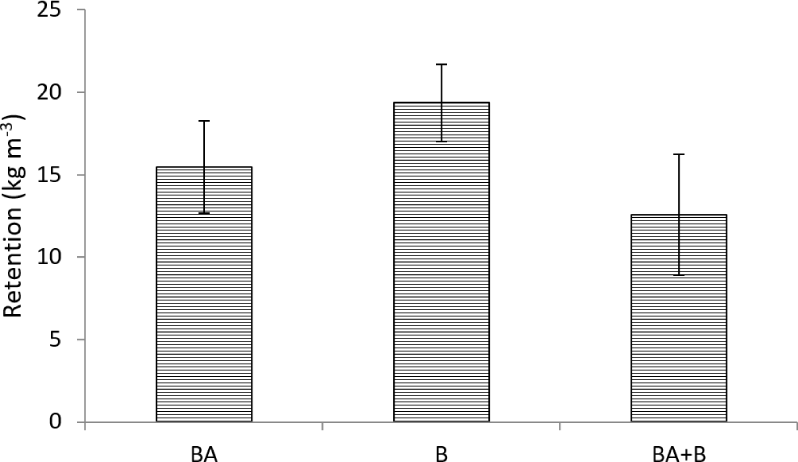
The weight percent gain (WPG) of citric acid (CA) in heat-treated at 80°C was higher than that heat-treated at 160°C, which were 8%–10% and 1%–6%, respectively. The highest WPG was seen in the treatment of borax, CA and heat-treated at 80°C (Fig. 2). The higher temperature caused more water evaporation and some chemical changes in wood, particularly hemicelluloses and extractives. As reported by Doll et al. (2006) that during wood modification, water was released. In addition, Mubarok et al. (2020) reported that high temperature treatment under acid condition could degrade wood components.
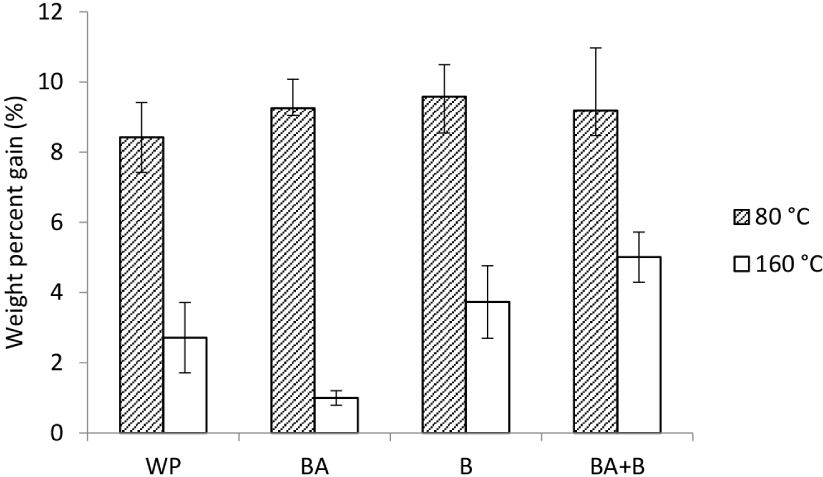
This research revealed that CA impregnation could not protect Samama wood from brown rot fungus T. palustris. Fig. 3 showed that citric acid treated sample had greater weight loss than sample without citric acid (WCA). Borax-citric acid treatment (BCA) also caused lower weight loss than borax-without citric acid treatment (BWCA), indicating that the protection from brown rot is more effective when CA is combined with borax. Furthermore, 160°C heating increased the durability of samama wood against brown rot.
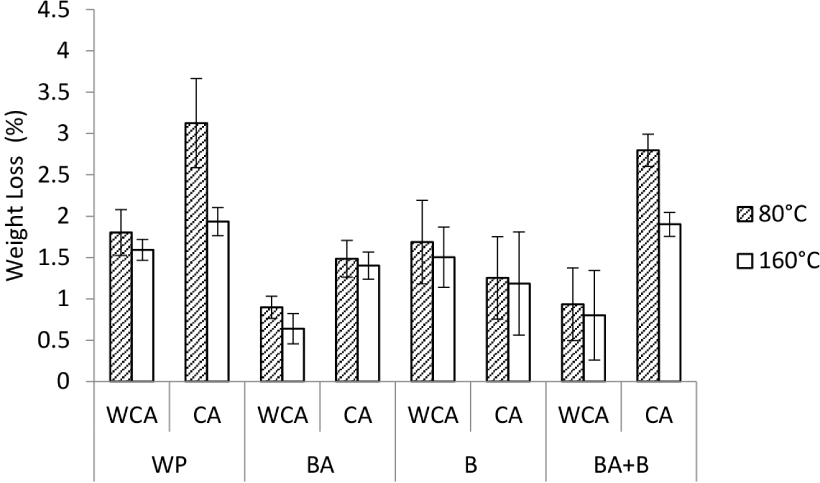
Citric acid treatment did not improve wood resistance against white rot fungus S. commune (Fig. 4) that indicated by higher weight loss, except in citric acid followed by heat treatment at 160°C (WB-CA160) and borax-citric acid followed by heat treatment at 160°C (B-CA160). The best protection from brown- and white rot attack in Samama wood occurred in the treatment with BA followed by heat treatment at 160°C (BA-WCA160).
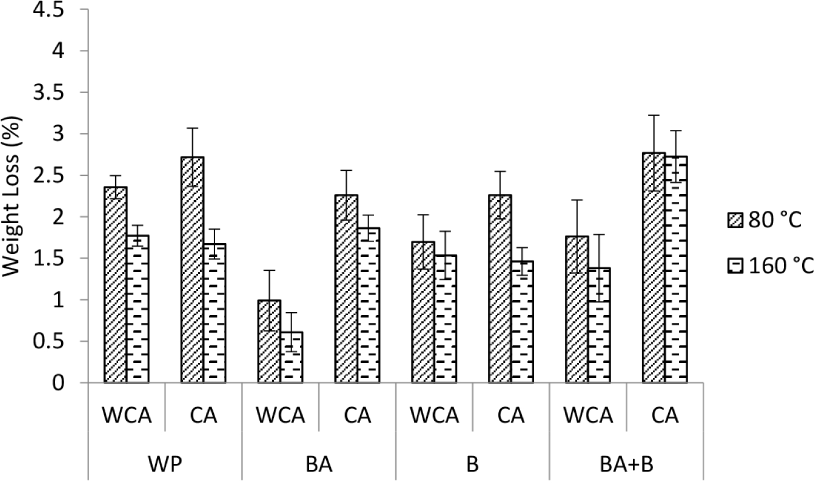
The heat treatment at 160°C consistently increased the durability of Samama wood. All samples treated in the temperature of 160°C had the weight loss lower than those with the heat treatment of 80°C. The variance analysis (ANOVA) showed that heat treatment, boron impregnation and citric acid modification have a significant effect on Samama wood’s durability against brown- and white rot attacks. All interactions between factors are statistically significant, except the interaction between CA and heat treatment (p = 0.1558) in white rot decay test. Previous research suggested that heat treatment degraded some chemical components of wood (Cao et al., 2022; Esteves and Pereira, 2009; Schulz et al., 2021). This degradation increased samama wood’s durability against fungal attacks.
Boron is one of the toxic chemical elements for drywood termites (DT). It is proven from the reduced DT attack to the Samama wood impregnated with boron preservatives (B and BA; Fig. 5). Moreover, when boron preservative was combined with CA, the weight loss of wood was slightly less than that treated with boron preservative only. Heat treatment at 160°C inconsistently reduced drywood termite attack. The results of variance analysis also showed that the interaction of boron and citric acid had a significant effect on the weight loss of Samama wood by drywood termite attack. The previous research presented that the combination between boric acid and heat treatment at 140°C on Manii wood (Maesopsis eminii) decreased the DT (C. cynocephalus) attacks up to 50% (Istriana and Priadi, 2021). Furthermore, DT (Incisitermes minor) mortality was more than 80% in Sugi wood (Cryptomeria japonica) impregnated with disodium octaborate tetrahydrate (DOT; Kartal et al., 2020).
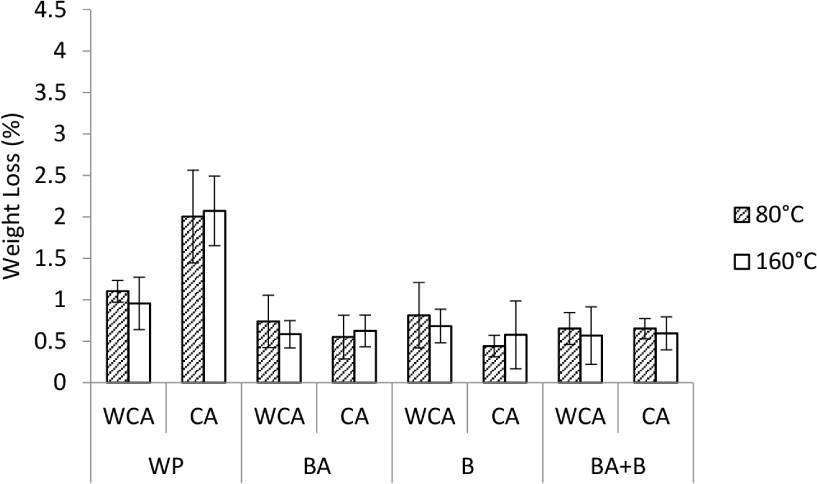
Fig. 6 shows that BA plays an important role in maintaining Samama wood’s durability from subterranean termite attacks. The weight loss of the test sample treated with boric acid (BA-WCA) had the least weight loss than other treatments. This was in accordance with the explanations made by Ahmed et al. (2004) stating that BA effectively reduced the weight loss of pine (Pinus radiata) and eucalyptus (Eucalyptus regnans) woods from the subterranean termite (Coptotermes acinaciformis) attacks. Boric acid was also reported successful to suppress the colonies of subterranean termites (Heterotermesindicola and Odontotermes sp.) which have low toxicity characteristics (Farid et al., 2015).
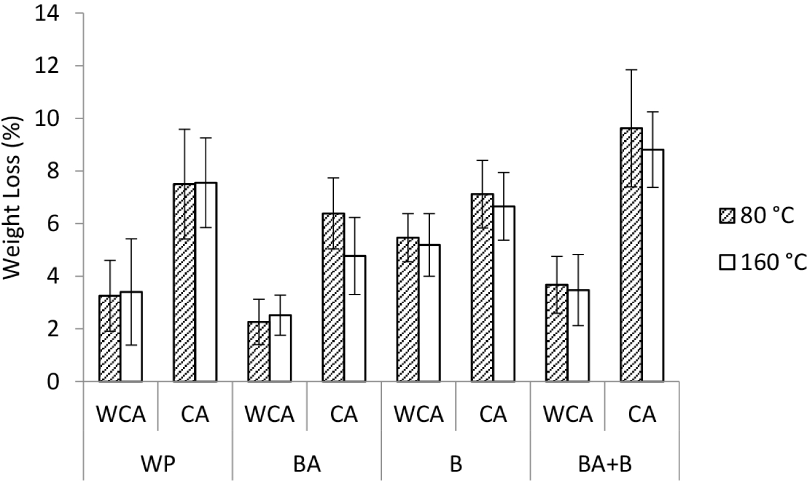
The combination of other treatments resulted in more weight loss than the untreated sample (WP-WCA). The second modification with CA failed to reduce the weight loss of wood by subterranean termites. In addition, the result of variance analysis also showed that the heat treatment at 160°C had no significant effect on subterranean termite attack.
The weight loss of the control test sample (WP-WCA-80) after a 12-week ground contact field test was greater than 60% (Fig. 7), which was mainly attacked by subterranean termites. Samama wood’s weight loss tends to increase after being impregnated with CA. Heating at 160°C reduced the weight loss of boric acid and borax-treated samples (BA-WCA-160 and B-WCA-160), which were less than the control sample (WP-WCA-80) too. However, the boron impregnation and all interactions did not significantly affect the weight loss in this field test.
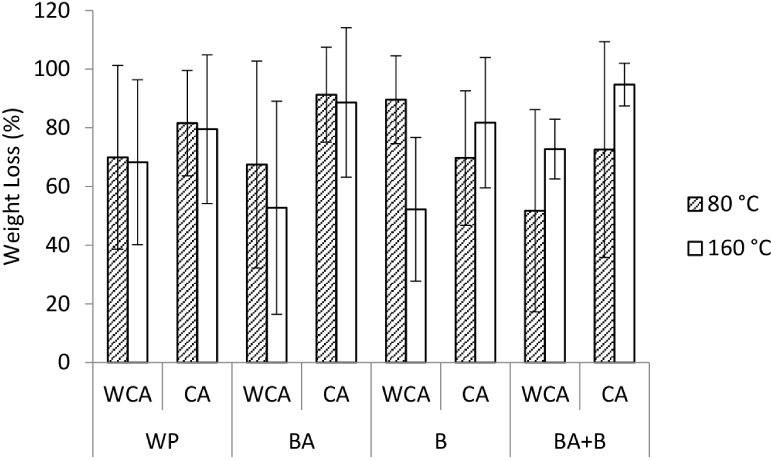
The visual evaluation of Samama wood after field test is presented in Fig. 8. The test sample damage indicated mainly due to subterranean termites. Most test samples have more than 75% damage, with their durability score being 0 based on ASTM D 1758-02:2002 standard. However, better resistance with the durability score 4 occurred in boric acid-heating 160°C and borax-heating 160°C treatments.
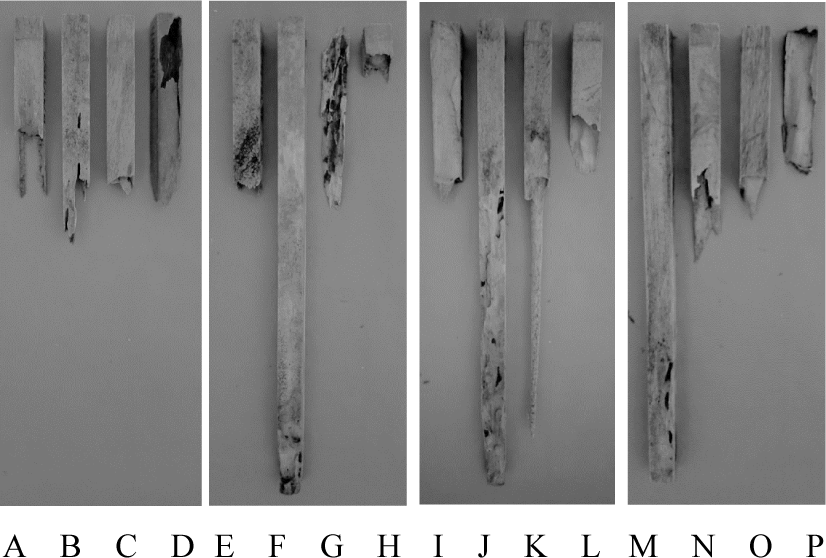
The test sample’s weight loss and damage in the field test are influenced by many factors. The temperature and humidity in the test location increased the activity of wood decay organisms, particularly termites (Arinana et al., 2020). Boron is indeed not recommended for outdoor use due to its weak bond with the wood. In addition, CA was also reported to be washed at a certain amount during the test (Mubarok et al., 2020; Rumbaremata et al., 2019). The results of this research on the impregnation of boron combined with CA- and heat treatment in Samama wood confirm that boron and CA are effective for hampering wood-decay organism attack. In addition, they are not recommended for extreme conditions such as outdoor use, direct contact with the soil and high humidity.
4. CONCLUSIONS
The investigation on the reliability of boron, citric acid and heat treatment of samama wood against decay fungi and termites resulted in the following important points:
-
Boric acid impregnation increased Samama wood’s durability against white- and brown rot fungi, and drywood- and subterranean termites.
-
The combination of boric acid or borax with citric acid and heating at 160°C reduced brown- and white rot decay.
-
Citric acid treatment could not protect Samama wood from wood-decay organism attack.
-
Heat treatment at 160°C resulted in a slight improvement in the resistance of Samama wood against brown- and white rot fungi and drywood termites.
-
The combination treatment of boron preservatives, citric acid and heating at 160°C was less effective when Samama wood was used for exterior uses and in direct contact with the soil.








